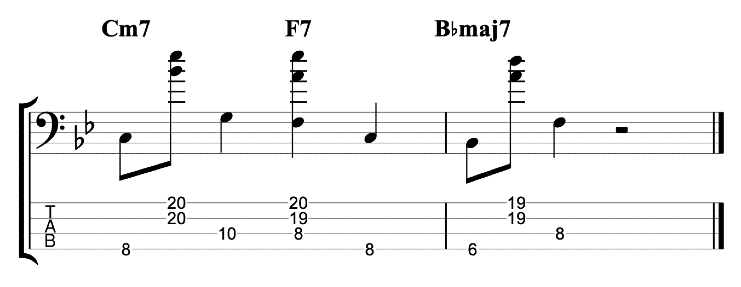Tapping Chords on Bass Guitar – Two-Hand Tapping Exercises – Part 2 – Bass Practice Diary – 10th November 2020
Last week was part one in my series of two-hand tapping exercises for bass guitar. I was looking at the basic technique of coordinating hammer ons and pull offs between both right and left hand. This week, I’m looking at tapping chords by hammering on notes simultaneously with both right and left hand.
Tapping Seventh Chords
These ideas should work on pretty much any bass guitar. I’ve used a 4-string bass in the video to demonstrate that you can make full sounding chord voicings on just 4-strings. My bass has 24 frets, but I’ve deliberately not gone above the 20th fret, so you can play everything in the video on a Fender style bass with 20 frets.
I’m playing 7th chords (major 7, minor 7 & dominant 7). These are four note chords, root, 3rd, 5th and 7th. The concept of this exercise is that I’m going to tap the root and 5th with my left hand and the 3rd and 7th with my right hand. The left hand notes are played on the 3rd and 4th strings and the right hand notes on the 1st and 2nd.
An Exercise to Develop Your Tapping Technique
Before you start, I would recommend practicing tapping four finger exercises with both hands. Something like this.

When I’m practicing exercises like this, my goal is not to play the exercise fast. My goal is to make good sounding notes and to get an even sound across four fingers and four strings. As I mentioned in the video, I never use my little finger on the right hand to tap notes when I’m playing music, but I still practice it. Why? Because maybe I’ll develop a technique that uses my little finger one day. Only practice the 3rd and 4th fingers on your right hand if you want to. For the purposes of this exercise, all you need are two fingers on your right hand.
Playing Chord Progressions
I’ve used a II-V-I progression in the video because it’s the most commonly used chord sequence in jazz. You can use any progression you want and any rhythm or style. But whatever you play, I would start by making a bassline out of the root and 5ths. Like this.

This exercise should be played entirely with the left hand and all of the notes are hammered on. The left hand notes are your bassline, they are the foundation of the groove. So, it’s worth practicing this until you get the feel where you want it.
When you have the feel, you can add the 3rds and 7ths with your right hand. These right hand notes should be played simultaneously. Not one after the other like the left hand notes. The right hand notes can be played simultaneously with the root note played by your left hand. This involves simultaneously hammering three different notes on three strings. You can see I’ve done this with the F7 chord. The F is hammered by the left hand while the A and Eb are hammered on by the right hand. Alternatively, you can hammer the right hand notes in between the left hand notes. You can see I’ve done this with the Cm7 and Bbmaj7 chords. Here is the II-V-I exercise.


